Website www.metro.net Line number 806 Number of stations 19 | Operator(s) Metro (LACMTA) Owner Los Angeles Metro Rail Transit type Light rail | |
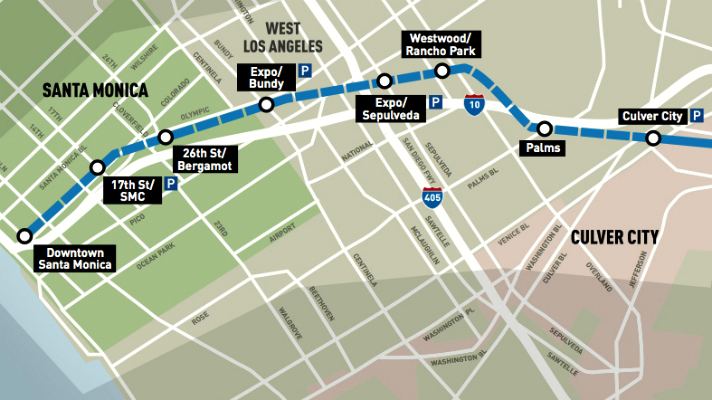 | ||
Daily ridership 43,199 (July 2016; avg. weekday) Began operation April 28, 2012; 4 years ago (2012-04-28) Character Mostly at-grade in private right-of-way, with some underground, street-running, elevated, and trench sections. Number of vehicles Nippon Sharyo P865, P2020
Siemens P2000
Kinki Sharyo P3010 Similar Downtown Santa Monica st, 7th Street/Metro Center st, Culver City station, Los Angeles Union Sta, La Cienega/Jefferson station | ||
The Expo Line is a light-rail line that runs between Downtown Los Angeles and Santa Monica. The line is named "Expo" after Exposition Boulevard, which it runs alongside for most of its route. It is one of the six lines in the Metro Rail system, and is operated by the Los Angeles County Metropolitan Transportation Authority (Metro).
Contents
- Construction
- Hours of operation
- Headways
- Speed
- Steam railroad
- Early electric service
- Abandonment
- Community rescue
- Naming and color
- Expansion
- Regional Connector Transit Corridor
- Station listing
- Maintenance facilities
- Rolling stock
- Bikeway
- References
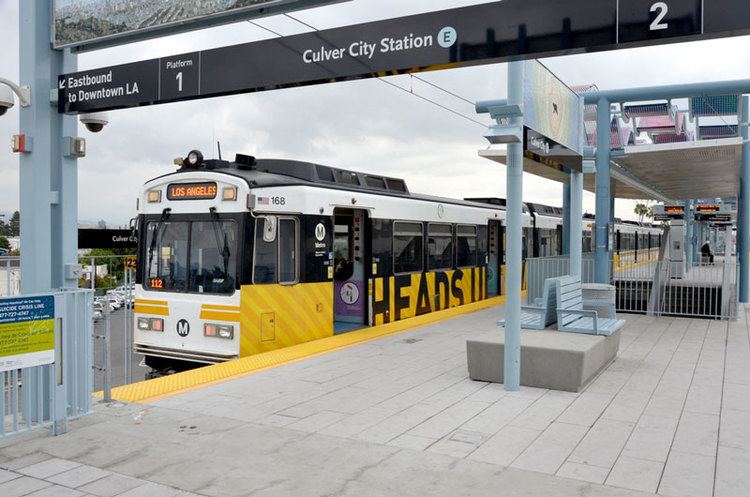
The Expo Line largely follows the right-of-way of the Santa Monica Air Line, which ceased operation in 1953. Several Expo Line stations are built in the same location as Air Line stations, although no original station structures have been reused.

Construction
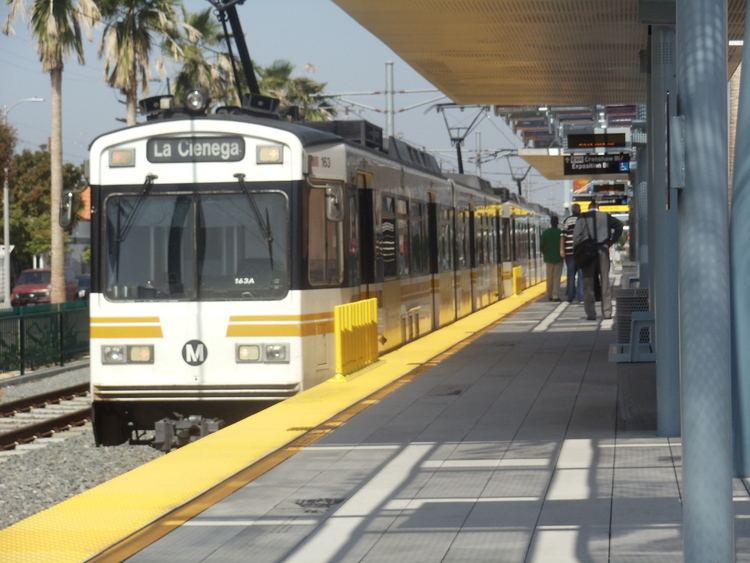
An independent agency, the Exposition Metro Line Construction Authority, was given the authority to plan, design, and construct the line by state law in 2003. After construction was completed, the line was handed over on January 15, 2016, to the Los Angeles County Metropolitan Transportation Authority for testing and operation.
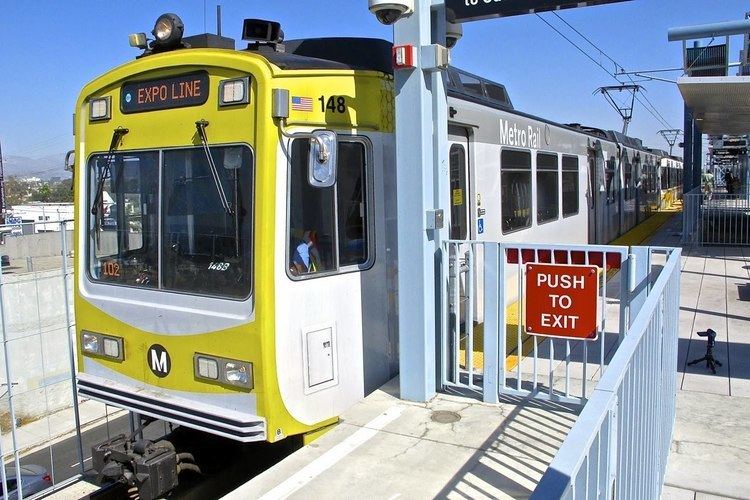
The line was built in two phases; the first phase comprised the 8.6-mile (13.8 km) section between Downtown Los Angeles and Culver City. Construction began in early 2006 and most stations opened to the public on April 28, 2012. The Culver City and Farmdale stations opened on June 20, 2012.
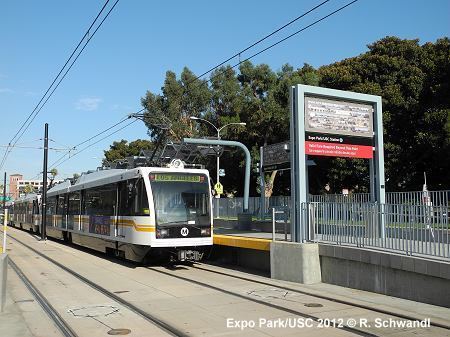
Design and construction on the 6.6-mile (10.6 km) portion between Culver City and Santa Monica started in September 2011. Testing along the phase 2 segment began on April 6, 2015, and the segment opened on May 20, 2016.
Hours of operation
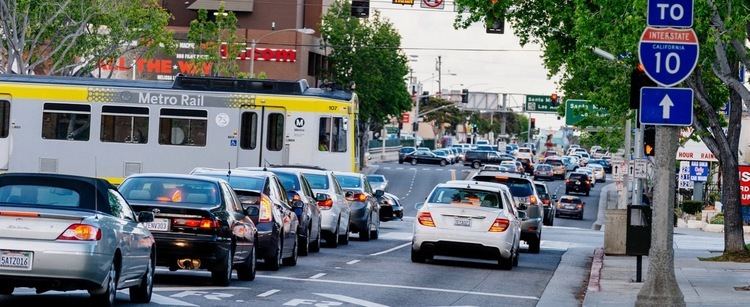
The Expo Line operates from approximately 4:30 a.m. to 2:00 a.m. on weekdays and until 2:30 a.m. on Fridays and Saturdays.
Headways
As of December 2016, trains run approximately every 6 minutes during peak hours, every 12 minutes during middays, every 10 minutes during the evening, and every 20 minutes after midnight.
Speed
Maximum speed on the route is 55 mph (89 km/h), though it generally runs much slower than this.
Steam railroad
The line was first built in 1875 as the steam-powered Los Angeles and Independence Railroad to bring mining ore to ships in Santa Monica harbor and as a passenger excursion train to the beach—first independently and later after purchase by the Southern Pacific Railroad in 1877. When the Santa Monica harbor closed to shipping traffic in 1909 the line was leased to Pacific Electric who converted it to electric traction.
Early electric service
By 1920 the line was called the Santa Monica Air Line providing electric-powered freight and passenger service between Los Angeles and Santa Monica. Electrically-powered passenger service stopped in 1953 but diesel-powered freight deliveries to warehouses along the route continued until March 11, 1988.
Abandonment
While Southern Pacific maintained ownership of the right-of-way after 1988, it no longer used or maintained the rails. Portions of the right-of-way were leased for use as storage facilities, parking lots, impound lots, and various businesses, but no permanent structures were built.
Community rescue
The abandonment of the line spurred concerns within the community to prevent the line from being sold off piecemeal—destroying one of the few remaining intact rail corridors within Los Angeles County. Advocacy groups including Friends 4 Expo Transit supported the successful passage of Proposition C in 1990, which allowed the purchase of the entire right-of-way from Southern Pacific by Metro (LACTC).
Metro successfully lobbied the federal government to use the remainder of Red Line funding for a different project to the Mid-City district of Los Angeles in 1998. That same year Los Angeles County voters approved Proposition A, another sales tax increase for transit, allowing Metro access to additional funds for transit projects. Metro then released a Major Investment Study in 2000 which compared bus rapid transit and light rail transit options along what was now known as the "Mid-City/Exposition Corridor". Construction began in August 2010.
Naming and color
Initially, the Expo Line was planned to be called the "Aqua Line". Plans were shelved in favor of the "Expo Line" designation, though the line retains the aqua color.
Expansion
Metro conducted study on the Expo Phase 2 from 2007 to 2009 and approved the project in 2010, with planned opening to Santa Monica in early 2016. The Expo Construction Authority officially handed over control of the Expo Phase II track to L.A. Metro for the county transit agency to begin pre-revenue train testing on January 15, 2016. This phase was opened on May 20, 2016.
Regional Connector Transit Corridor
The Regional Connector Transit Corridor (also known as the Regional Connector, Downtown Connector or Downtown Light-Rail Connector) is an under-construction light-rail subway corridor through Downtown Los Angeles that is to connect the current Blue and Expo Lines to the current Gold Line, and to allow a seamless one-seat ride between the Blue and Expo lines' current 7th Street/Metro Center terminus and Union Station.
Once the Regional Connector Transit Corridor is completed, the Eastside leg of the Gold Line will be connected to the Expo Line. At the same time, the northern leg of the Gold Line through the San Gabriel Valley will be joined with the current Blue Line connecting Downtown Los Angeles and Long Beach, creating what will be the longest light-rail transit line in the United States. Names and/or colors for these new lines have not yet been officially announced, but it seems likely that the current Expo Line-eastern leg of the Gold Line will become the new Gold Line, and the Blue Line-northern leg of the Gold Line will become the new Blue Line. Under a proposed system in which each Metro rail and BRT line would be assigned a letter and a color, the current Expo Line and the southern leg of the current Gold Line would be combined into the gold-colored Line E, retaining elements of the identities of both current lines. The groundbreaking for the construction of the Regional Connector Transit Corridor took place on September 30, 2014, and the alignment is expected to be in public service by early 2020.
Station listing
The following is the complete list of stations from Downtown Los Angeles traveling west.
Maintenance facilities
Previously, the light rail vehicles used on the Expo Line were maintained at the division 11 yard in Long Beach, California, the same maintenance facility that is used by the Blue Line. However, the new division 14 yard, located east of Stewart Street and north of Exposition Boulevard in the vicinity of the 26th Street/Bergamot station in Santa Monica, was opened with the completion of Phase 2.
Rolling stock
Compatible with the rest of Metro's light-rail network, the Expo Line shares standard Metro light rail vehicles (Nippon Sharyo P865 and P2020, and Siemens P2000) with the Blue Line. Metro estimates that it has 47 light rail cars to provide service on the Expo Line under the peak-hour assumption of 3-car trains running at 6-minute headways.
Upon completion of Phase 2, it is expected that new P3010 light rail vehicles (LRVs) from Kinki Sharyo, that were ordered by the L.A. Metro board of directors in 2012, will begin operation, replacing the current LRVs in operation on the Expo Line.
Bikeway
The Expo Line Bikeway parallels the route of the light rail line, and includes a mixture of bike lanes on Exposition Boulevard and off-street paths alongside the rail tracks.
